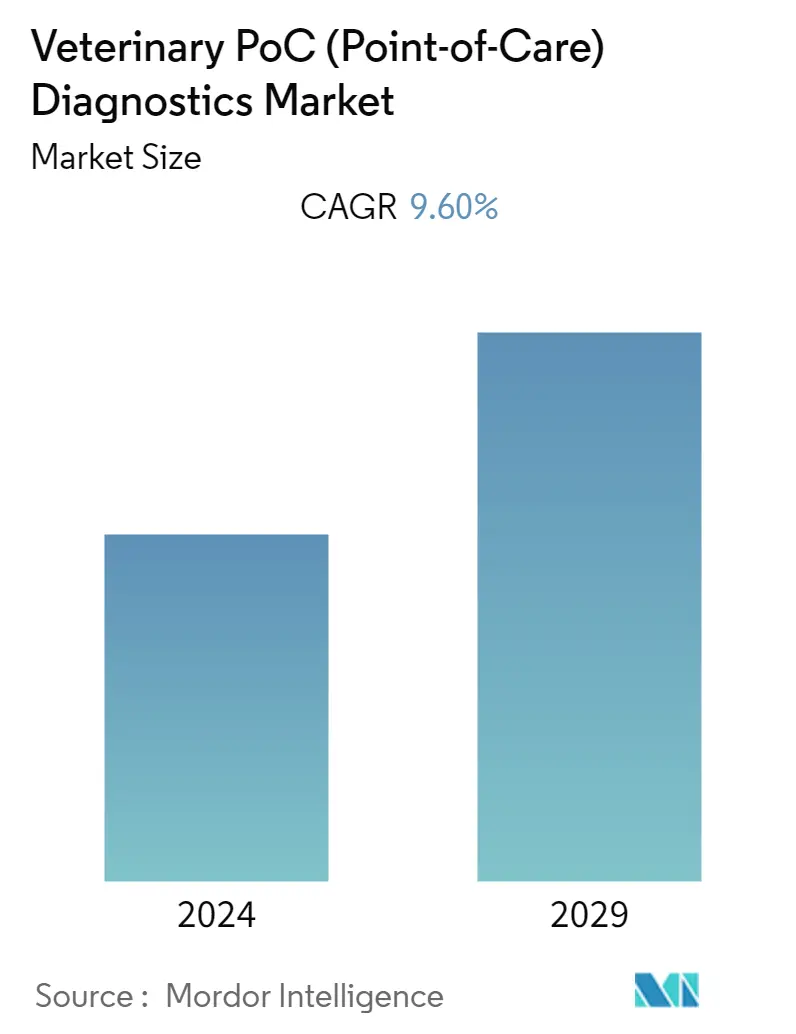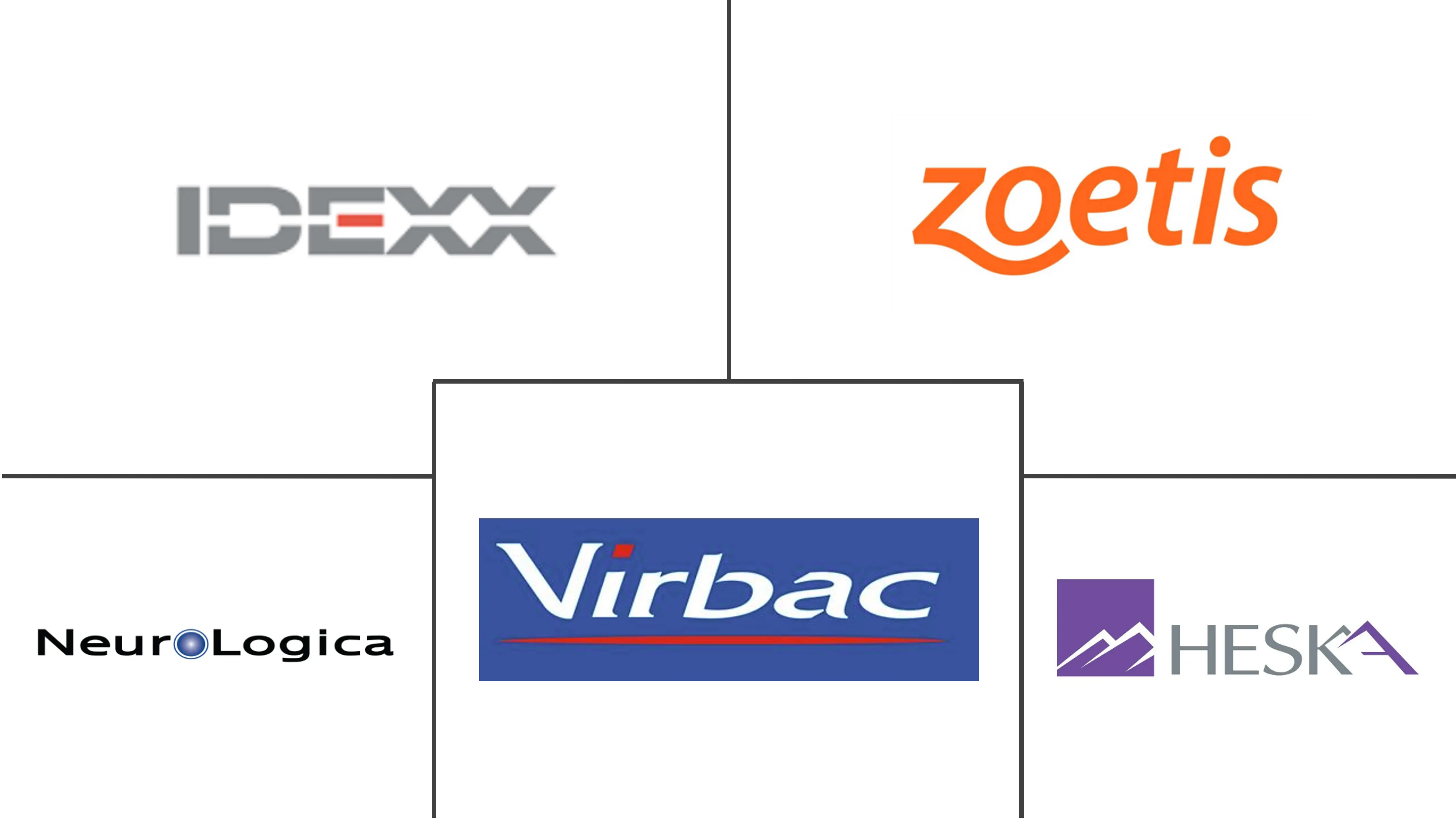Market Size of Veterinary PoC (Point-of-Care) Diagnostics Industry

| Study Period | 2019 - 2029 |
| Base Year For Estimation | 2023 |
| CAGR | 9.60 % |
| Fastest Growing Market | Asia-Pacific |
| Largest Market | North America |
| Market Concentration | Medium |
Major Players
*Disclaimer: Major Players sorted in no particular order |
Need a report that reflects how COVID-19 has impacted this market and its growth?
Veterinary PoC (Point-of-Care) Diagnostics Market Analysis
The Veterinary PoC (Point-of-Care) Diagnostics Market is expected to register a CAGR of 9.6% over the forecast period.
The COVID-19 pandemic has initially had a slightly positive impact on the veterinary PoC (point-of-care) diagnostics market. At the onset of the novel coronavirus pandemic, a public lockdown was imposed. Due to the imposition of lockdown and social distancing, several factors led to a surge in pet adoption by people, which was helpful in getting rid of the loneliness and anxiety caused by isolation. As COVID-19 emerged from animals, the government, healthcare organizations, and media helped to raise awareness about the risk of zoonotic disease spread during the pandemic. The collective efforts of these bodies lead to increased knowledge of zoonotic infections, prevention, and hygiene for companion and livestock animals. Some of the leading companies operating in the veterinary PoC diagnostic market have witnessed mild growth in their revenues. For instance, IDEXX reported growth of only 3% from 2019 to 2020 and 27% growth from 2020 to 2021 in its veterinary, software, services, and diagnostic imaging systems segments.
Further, Zoetis reported revenue growth of only 7% from 2019 to 2020 and 16% growth in its revenue from 2020 to 2021 in its veterinary, software, services, and diagnostic imaging systems segments. In March 2020, IDEXX announced that it had found no positive results in pets with SARS-CoV-2. The company evaluated thousands of feline and canine samples to validate the new veterinary diagnostic test for the virus. This shows that the market for veterinary PoC has been mildly impacted by the pandemic, and the companies achieved robust growth in 2021. Thus, the COVID-19 outbreak had a mildly positive impact on the market's growth in its preliminary phase, with more pet adoptions and an increase in veterinary PoC testing. Moreover, the market is expected to grow further at a stable pace with the increasing demand for zoonotic disease diagnosis globally.
Furthermore, the increasing prevalence of zoonotic infections and their transmission to humans globally aided market growth. The market's growth is driven by the rising prevalence of zoonotic diseases and their transmission to humans, increasing pet adoptions and the number of veterinary healthcare professionals, and increasing research into veterinary disease diagnosis. According to a study published in the Faculty Reviews 2022, over 60% of the infections in humans have zoonotic origins, and over 40% of the infections have either emerged from non-zoonotic sources or co-evolved with humans. Recently, there have been several zoonotic-origin infections that resulted in an outbreak and have impacted the human population globally. Apart from the novel coronavirus, some zoonotic infections have recently impacted humans, including swine flu, Ebola, monkeypox, the zika virus, and others. According to the World Health Organization (WHO) 2022, there were over 130 reported cases of Ebola in the Democratic Republic of the Congo in 2020. On April 23, 2022, an outbreak of Ebola was declared by the health authority of the Congo. In July 2022, WHO declared the current monkeypox outbreak a public health emergency of international concern (PHEIC), overriding the WHO Emergency Committee. By November 2022, WHO had confirmed over 80,221 cases and 52 deaths from monkeypox in over 110 nations.
In addition, research in the area of effective diagnosis and monitoring of zoonotic diseases has been rising. The advancing research and use of veterinary PoC testing have helped in the management of antimicrobial resistance. According to the October 2022 issue of Acta Veterinaria Brno, the incoming advanced technologies in veterinary PoC include the development of microfluidics, lab-on-a-chip technologies, biosensors, bioanalytical platforms, complementary technologies, and others. Over time, PoC diagnosis contributes significantly to the monitoring of zoonotic diseases. As per the International Journal of Infectious Diseases 2021, current efforts are being made to utilize PoC for zoonotic diseases such as zoonotic tuberculosis (zTB), which accounts for 1.4% of the cases of global tuberculosis. Further, CRISPR-based technologies as a platform for zoonotic PoC testing are being researched. A study published in the journal Methods 2022 has highlighted the use of CRISPR Cas for diagnosis and point-of-care nucleic acid detection by using the Cas proteins (Cas3, Cas9, Cas12, etc.) to detect various infectious agents.
Therefore, owing to the aforementioned factors, it is anticipated that the studied market will witness growth over the analysis period. However, the high cost of veterinary imaging instruments will likely impede the market's growth.
